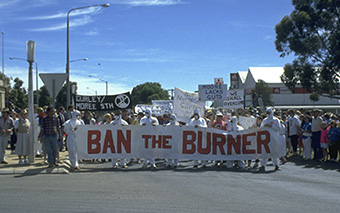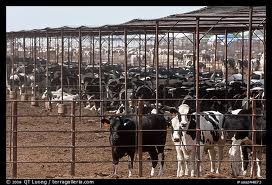The shade of green a group is can determine the sort of issues it focuses. Phil Tighe and Ros Taplin noted at the Ecopolitics IV Conference:
Forestry and wilderness issues in Australian have been distinguished by three related features: they attract significant middle class popular support, particularly in the capital city electorates; they centre on the preservation (or destruction) of aesthetic landscapes at considerable distance from these urban centres of greatest support; and they never directly challenge the dominant economic and material concerns of their supporters.
More importantly the stance that one takes on an issue will be determined by one’s shade of green. In practice this can lead to environmentalists taking opposing sides in a controversy.
The involvement of the Australian Conservation Foundation (ACF) in the hazardous waste issue in the 1980s was one of working with government. They were represented on the four member Joint Taskforce on Intractable Waste which was set up to establish a high temperature incinerator for burning hazardous wastes. They negotiated with government to ensure certain conditions were incorporated into the legislation and in return they helped to convince the public that the incinerator would be completely safe and to get other environmental groups to support it.
 However the high temperature incinerator was an issue that highlighted the differences in attitudes between light and dark greens. The ACF was opposed by other environmental groups such as Greenpeace and Friends of the Earth who raised questions about whether environmentalists should help industry to dispose of wastes that should not have been produced in the first place; questions about whether it was likely governments would build an expensive end of the pipe solution for hazardous wastes and still do all that was necessary to minimise wastes once it was built; questions about whether enough is known about hazardous waste incinerators to guarantee their safety; questions about whether, if incinerators are not safe, a rural community and its environment should be sacrificed so hazardous wastes could be moved out of the city.
However the high temperature incinerator was an issue that highlighted the differences in attitudes between light and dark greens. The ACF was opposed by other environmental groups such as Greenpeace and Friends of the Earth who raised questions about whether environmentalists should help industry to dispose of wastes that should not have been produced in the first place; questions about whether it was likely governments would build an expensive end of the pipe solution for hazardous wastes and still do all that was necessary to minimise wastes once it was built; questions about whether enough is known about hazardous waste incinerators to guarantee their safety; questions about whether, if incinerators are not safe, a rural community and its environment should be sacrificed so hazardous wastes could be moved out of the city.
In 1999 the Arizona branch of The Nature Conservancy (TNC) sided with the livestock industry in a coalition called the Arizona Common  Ground Roundtable, “dedicated to helping save Arizona’s diminishing grasslands”. It called for more government subsidies to ranchers using public land and ‘reform’ of the Endangered Species Act (ESA). TNC defended this position by arguing that the laws were forcing ranchers to sell their private land for housing subdivisions and other developments that would fragment the grasslands and open spaces.
Ground Roundtable, “dedicated to helping save Arizona’s diminishing grasslands”. It called for more government subsidies to ranchers using public land and ‘reform’ of the Endangered Species Act (ESA). TNC defended this position by arguing that the laws were forcing ranchers to sell their private land for housing subdivisions and other developments that would fragment the grasslands and open spaces.
The Roundtable was held up as a prime example of environmental conflict resolution: “Americans are tired of hearing about confrontations in the environmental area. They would prefer organizations with environmental goals utilize the strengths of one another and work toward the common goal of environmental protection.”
However 18 environmental groups put their opposition in writing to the TNC:
Preserving open space, however, is not the be-all and end-all of environmental protections. It is also absolutely necessary to preserve clean water, recreational opportunities, wildlife habitat, and endangered species. Instead of integrating these needs, the Arizona Common Ground Roundtable establishes a false choice between allowing cattle grazing to continue soiling our land and water, and the preservation of open space.
The groups argued that the ESA was not causing extra costs to ranchers although ranchers often blamed it for their troubles. However grazing was causing declining water quality, damaging ecosystems and endangering species. They pointed to a study done in partnership with TNC scientists that found that livestock grazing threatened a third of all species listed as endangered by the US Fish & Wildlife Service, the National Marine Fisheries Service, and TNC. It was only marginally behind development as a national threat and a Forest Service report found that in Arizona it was the main threat to species.
A former TNC science director, Jerry Freilich, also claims that the pounding hooves of cattle degrade fragile environments and claims that in 2000 he was pressured and physically bullied by his boss at TNC to sign documents certifying that specific cattle ranches, which he had never visited, were environmentally sound. (He signed and subsequently resigned and made a complaint to the police. His complaint led to a settlement with TNC a year later.) All but three of the remaining 95 scientific staff at TNC headquarters were subsequently dispersed to branch offices or reassigned to a new organization that services TNC and sells TNC biological data.